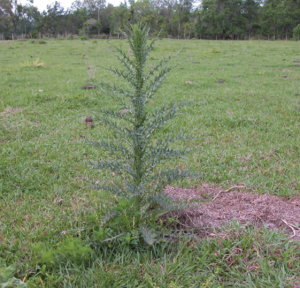The thistle has long been an enemy of ranchers, county roadside maintenance crews and homeowners. Often difficult to control, it causes both headaches for producers, in reduction of grazing for livestock as well as being an eyesore for gardening enthusiasts. There are nine different species of thistle in Florida. Most of these are closely related, therefore the control protocols are the same. Only one species is a perennial, and all others are biennial. A biennial plant grows from seed in one year and produces seed for the next.

Thistle that has begun to bolt. Photo Credit: Dr. Jason Ferrell, University of Florida/IFAS Agronomy Department-Weed Science.
It’s important to understand the biology of the thistle in regards of seeking control of this fast spreading weed. This plant will grow a taproot and a cluster of leaves in the first year. This is known as the rosette stage. In the second year, a stalk will appear from the center of the rosette. This is called “bolting”. A seed head will form once the bolting stage is complete. Amazingly, one thistle plant can amass 4,000 seeds. The plant faces its demise after releasing the seeds. The rosette growth stage is mostly during the winter months with bolting occurring from January to July. This is important to note when battling this persistent weed.
As for control, preventing the thistle from producing seed is the most important management measure. Otherwise, little can be done to stop the outbreak of the weed. For homeowners, manually removing the rosette and tap root by hand is effective with small stands. Be careful and wear protective coverings on your hands and arms. Keep in mind, the plant will come back if the tap root is not fully removed.
Other physical control methods, like mowing, have mixed results. This can be effective if mowing occurs after the bolting stage has occurred, but before the seed head forms. However, this is tricky, as thistle plants often do not bloom at the same time.
Thistles in the rosette stage are very susceptible to herbicides. Although, applying a herbicide after the seed head has formed has little effect on control. Herbicides containing 2,4-D are very effective for landscapes. Timing of application is critical. The key to controlling this weed is by scouting and identifying stands as early as possible.
If you’re a beekeeper, there is an upside to this weed. Delicious honey can be made from the thistle bloom.
For more information on thistle, please contact your local county extension office.
Supporting information for this article can be found in the UF/IFAS EDIS Publication, “Thistle Control in Pastures” by Dr. Brent Sellers and Dr. Jason Ferrell.
UF/IFAS Extension is an Equal Opportunity Institution.
- Why Are Sand Dunes & Sea Oats So Important? - March 20, 2025
- How to Care for a Gift Plant - December 5, 2024
- Fall Leaf Colors Are Just Around the Corner - September 4, 2024
